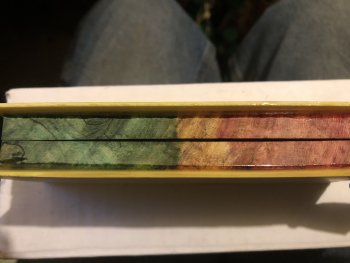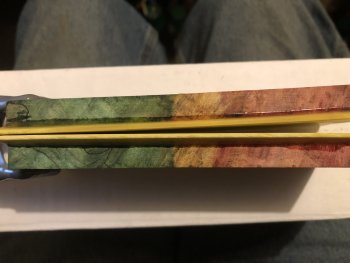SS369
Well-Known Member
Good day all.
Needing some input on the why it happens and potential fixes.
I have well stabilized scales of various woods, burls, some dyed, some
not.
I flatten them on a flat plate, till I cannot see between them, using 60
grit paper finishing with figure eight motions.
I did not use powered sanding so no heat was introduced.
Against each other they were flat and almost "Stick" together.
I then glue G10 liners with a thin smear of GFlex epoxy, prepped and all
cleaned with denatured alcohol.
Clamping is done with small spring clamps, three per scale, on a flat
piece of angle iron.
After a 24 hour cure, I remove them and notice that they are bowed from
each other, sufficiently so that if I flatten to remove the bow, the
liners will look pretty sorry.
I am trying to straighten them by clamping and over shimming where
needed and placing the affair in front of a space heater, rotating every
so often.
So far no improvement.
This has happened before and I can't stomach wasting such beautiful,
unique materials.
Any ideas for salvaging these and possibly future work?
Thanks in advance,
Scott
Needing some input on the why it happens and potential fixes.
I have well stabilized scales of various woods, burls, some dyed, some
not.
I flatten them on a flat plate, till I cannot see between them, using 60
grit paper finishing with figure eight motions.
I did not use powered sanding so no heat was introduced.
Against each other they were flat and almost "Stick" together.
I then glue G10 liners with a thin smear of GFlex epoxy, prepped and all
cleaned with denatured alcohol.
Clamping is done with small spring clamps, three per scale, on a flat
piece of angle iron.
After a 24 hour cure, I remove them and notice that they are bowed from
each other, sufficiently so that if I flatten to remove the bow, the
liners will look pretty sorry.
I am trying to straighten them by clamping and over shimming where
needed and placing the affair in front of a space heater, rotating every
so often.
So far no improvement.
This has happened before and I can't stomach wasting such beautiful,
unique materials.
Any ideas for salvaging these and possibly future work?
Thanks in advance,
Scott


